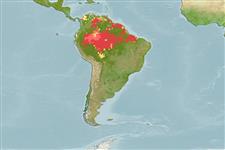Classification / Names
Common names | Synonyms | Catalog of Fishes (gen., sp.) | ITIS | CoL | WoRMS | Cloffa
Actinopterygii (ray-finned fishes) >
Clupeiformes (Herrings) >
Pristigasteridae (Pristigasterids)
Etymology: Pellona: Derived from Latin, pellis = skin (Ref. 45335).
Environment / Climate / Range
Ecology
Freshwater; brackish; pelagic. Subtropical, preferred ?; 10°N - 35°S
South America: Argentina (Rio de la Plata down to Buenos Aires, Rio Paraná), Uruguay (Rio Uruguay), Brazil (Rio Tapajoz, Amazon as far up as Rio Jurua and down probably to mouth), the Guianas (Surinam, Guyana), Venezuela and Colombia (Orinoco from Rio Manacacias at Puerto Gaitan to Orinoco mouth). Reported from French Guiana (Ref. 27233).
Size / Weight / Age
Maturity: Lm ? range ? - ? cm
Max length : 73.0 cm TL male/unsexed; (Ref. 5217); common length : 45.0 cm TL male/unsexed; (Ref. 5217)
Dorsal
spines
(total): 0;
Dorsal
soft rays
(total): 0;
Anal
spines: 0;
Anal
soft rays: 38 - 46. Belly with 20 to 24 + 12 to 14, total 32 to 37 scutes. Lower jaw projecting; upper jaw with a toothed hypo-maxillary bone between hind tip of pre-maxilla and lower bulge of maxilla blade; lower gill rakers 23 to 31 (in fishes of 10 to 50 cm standard length, with the lower numbers in larger fishes). Pelvic fins with distinct axillary scale; anal fin origin under dorsal fin base.
Riverine, apparently not entering the sea, although presumably tolerating some salinity at river mouths. Not clearly distinguished from P. castelnaeana in the past, so that previous biological or fishery data may apply to either species. Flesh considered low quality (Ref. 5217). Seldom captured in the lower reaches of rivers (Ref. 27188).
Life cycle and mating behavior
Maturity | Reproduction | Spawning | Eggs | Fecundity | Larvae
Whitehead, P.J.P., 1985. FAO Species Catalogue. Vol. 7. Clupeoid fishes of the world (suborder Clupeioidei). An annotated and illustrated catalogue of the herrings, sardines, pilchards, sprats, shads, anchovies and wolf-herrings. FAO Fish. Synop. 125(7/1):1-303. Rome: FAO. (Ref. 188)
IUCN Red List Status (Ref. 115185)
CITES (Ref. 94142)
Not Evaluated
Threat to humans
Harmless
Human uses
Fisheries: subsistence fisheries
More information
Common namesSynonymsMetabolismPredatorsEcotoxicologyReproductionMaturitySpawningFecundityEggsEgg development
ReferencesAquacultureAquaculture profileStrainsGeneticsAllele frequenciesHeritabilityDiseasesProcessingMass conversion
Tools
Special reports
Download XML
Internet sources
